How to do Email Marketing for Real Estate Businesses?
When you need a new toothbrush, you can make a hasty, impulsive purchase. You can also get one while waiting in line at the pharmacy. The same cannot be said for purchasing or renting a home. Houses are high-priced products that necessitate a great deal of thought and deliberation before making a decision.
This means that real estate marketers must devote time to cultivating clients to have their trust. They can’t rush to the sale or try to force potential buyers to make a decision.
There are tons of stories about realtors email-spamming their customers with irrelevant emails for homes in places they are not even interested in or way out of their price range. To make email marketing work for your real estate business, you need a solid strategy rather than just sending random information to as many people as possible.
Real estate email marketing can take a lot of effort, but the payoff is considerably bigger than that of selling one toothbrush. In this article, I will share with you everything you need to know about real estate email marketing and how you can use it to attract and retain customers.
Yes, Real Estate Has Gone Digital!

Did you know that millennials (people born between the early 1980s and the early 2000s and ranging in age from 18 to 36 years) make up the majority of homebuyers worldwide? This is fantastic news for real estate agents because it means that there are a lot of people looking to purchase their first home and move out of their parents’ homes!
While having a large number of prospects is beneficial to realtors, the millennial generation presents a whole new set of challenges. For instance, millennials are part of our generation’s digital revolution and are well-versed in emerging technologies. Instead, they are no longer influenced by conventional marketing outlets such as print, radio, and television and instead prefer something more targeted and personal.
According to a National Association of Realtors survey, the first step in the home buying process for all generations of home buyers is searching online for properties for sale. This is why it is important for real estate agents to rise above their conventional marketing methods in favor of newer, more effective ways of communicating with their target audience. Email is a perfect way to do this. There are many advantages of email marketing for realtors. The first thing you should understand is why you should use email marketing.
To save time and get more out of your efforts
Once you’ve created a winning email campaign (which we’ll go over later), you should sit back and let the automation do its thing. The great thing about email marketing is that it can be automated. So, once you’ve developed your email list and planned your communications, you can concentrate on higher-ticket tasks like closing sales.
Build your real estate brand
Your agency’s brand should be explicitly reflected in your real estate email marketing. Your company already has a reputation in your culture, and your email marketing should build on that. You can effectively build out your brand by creating relevant content and providing value.
Strengthen relationships with real estate clients and prospects
As a real estate agent, the primary objective is to interact with your clients and potential buyers. Targeted email blasts and campaigns will assist you in accomplishing this goal by cultivating established partnerships and presenting your brand to new prospects. One of the most effective ways to cultivate interaction is through real estate content.
Generate more revenue
Real estate email campaigns are a great way to nurture leads and turn them into sales. Email offers a personalized way to communicate with prospects and learn more about their needs. That valuable data can then be used to close deals and generate revenue.
Real Estate Email Marketing Best Practices

Now that you understand the importance of emails in real estate and the main factors to consider before embarking on your email marketing journey, it’s time to delve into the key tactics used by smart realtors to optimize email marketing. Here are some of the best techniques for using emails for real estate marketing:
Scheduling
Although email is an excellent marketing tool, it should not be used excessively. Make a plan for your newsletters and make sure you send out only relevant content to your audience. Value the customer’s time by not being the “pushy salesman.” Experiment with different schedules to see when you get the most email opens.
Mix your content up

Although real estate customers often expect property listings from email newsletters, you are not limited to that type of content. Mix it up by sending out other related content such as nearby restaurants, tour guides, the best places to visit in the area of a given piece of real estate, and so on.
Sales is less about marketing your products and more about developing real relationships with your customers so that they feel motivated to purchase from you. Changing up your content is another perfect way to stand out from the crowd.
Maintain a small but active audience
Kevin Kelly, the co-founder of the well-known Wired journal, wrote a great blog post about the importance of getting 1000 true fans and how a small group of people is enough to make your company effective (no matter what industry you belong to).
This is particularly true in email marketing, where having a small group of active members who read your email on a regular basis is far superior to having a large number of people who never interact.
Be sure to refresh your email list regularly, add new users to your excel sheet (or wherever you store your list of subscribers), and remove them if they request it. Don’t be afraid of unsubscribers; instead, concentrate all of your efforts on those who enjoy what you have to offer!
Newsletters are your best friend
Email newsletters are a go-to strategy for top realtors to leverage email marketing. An email newsletter is the best way to harness the power of email. This is why 83% of B2B marketers have email newsletters in their marketing strategy, and 40% of B2B marketers say email newsletters are the most important factor in their content marketing performance.
Newsletters are an excellent way to display several real estate listings in a visually appealing format. Sending your property listings to one person at a time can be very exhausting. This is why newsletters are one of real estate agent’s preferred email marketing resources for showcasing listings.
Newsletters not only save you time and energy, but it also allows you to reach any many people as you need to. It normally takes about 10 minutes to build and send an email newsletter on a regular or weekly basis with email newsletter marketing tools, making it one of the main strategies that any realtor should use.
Make your email design stand out

Email design is very important. Visually appealing content captures the user’s attention easily and entices them to read more. Furthermore, since a prospect may have subscribed to several email newsletters from various real estate agents or agencies, you must ensure that your email stands out.
Doing it in accordance with the brand values and employing a distinct distinctive look makes all the difference. When your audience opens your email, they should automatically recognize your brand. This does not, however, imply that all of your emails and newsletters must look the same.
Experiment with various email templates and keep a couple of them in your pocket for different purposes. You can have various email templates for different purposes, such as sign-up confirmation, appointment confirmation, property listings email, and so on.
To keep this process as time-efficient as possible, use an email marketing tool with pre-made templates so that you don’t have to start from scratch every time you need to send out an email.
With smartphones ruling every corner of the globe, email opens on mobile devices continue to rise year after year. According to statistics, approximately 46% of all emails are opened on mobile devices. As a result, ensure that your email newsletter templates are mobile-friendly and look fantastic regardless of the screen on which they are displayed.
Create a landing page
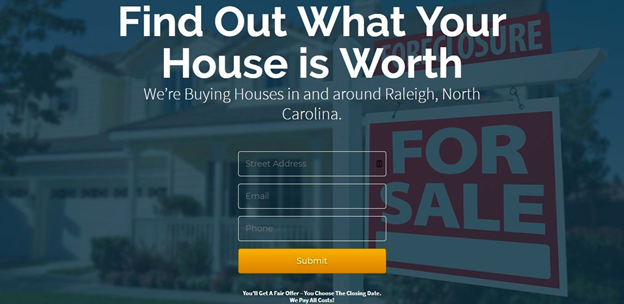
As previously mentioned, the first step in the home buying process is to check online for available properties for sale, whether on a property aggregation website like Zillow or on your own website.
It is important NOT to let any website visitor go without giving them the option to sign up for your newsletter. This not only gives you a larger audience to experiment with, but it also allows prospects to receive knowledge about your properties directly in their inbox without having to go online and browse.
Create dedicated landing pages for your email newsletters or simply embed a signup form on your real estate website to accomplish this. It is relatively simple to create a landing page or embed a signup form. Here are a few points to remember:
-
Keep your form simple: Avoid overloading your landing page or form with numerous headlines and pop-ups. Make the copy as brief as possible. The aim is to get the user to sign up for your email list rather than to annoy them with various advertisements and content.
-
Add relevant fields: In addition to the prospect’s name and email address, you can include real estate-related fields such as preferred budget, preferred place, move-in date, and more.
-
Optimize: Since the majority of users will visit your landing page on a mobile device, make sure your form is tailored for various screen sizes. The easier you make it for your target audience to sign up, the better.
-
A straightforward and visible call to action (CTA) button: Finally, make sure the call to action (CTA) button is clear, crisp, and visible.
Segmentation is key
On average, people get 121 emails a day. Every day, the world receives 193.3 billion emails! People actively avoid any email that is not important, making segmentation a critical component of email marketing.
It is becoming increasingly important to segment the audience based on criteria such as demographics, place, stage in the purchasing process, or the development of event-based triggers.
The more valuable your content is, the more likely you are to remain on top of your consumers’ minds and develop a relationship. Higher commitment, higher open rates, and a greater sense of confidence and reputation result from segmentation.
Collect as much data as possible about your audience, whether it’s through a sign-up form, a phone call, a social media interaction, or something else. If you’ve gathered enough details about your prospects, compile it all in an Excel spreadsheet and segment your audience accordingly.
Read more: How to Segment an Email List?
These are some of the most effective email marketing tactics used by savvy realtors to connect with prospects.
Aside from the tactics listed above, top real estate agents also use email marketing tools to assist them with all we discussed above and to keep their workflow smooth and headache-free. Here are some of the best email marketing tools for real estate.
Best email marketing tools for real estate businesses
AVADA Email Marketing
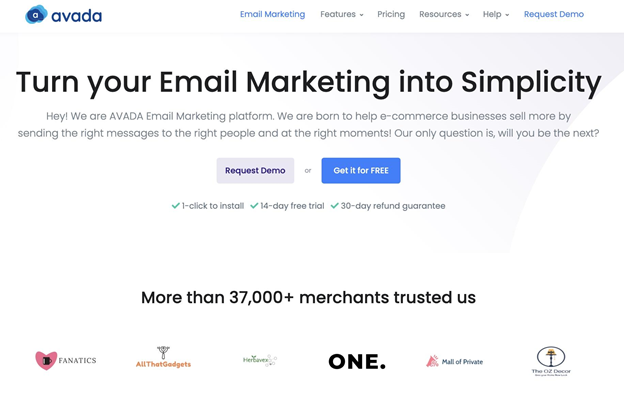
AVADA Email Marketing is extremely simple to use. They have an easy-to-use interface, and you won’t waste time going through training or guides. Their pre-made templates provide much more versatility and imagination - you can create a one, two, or three-column layout, view photos and social media options, and display the social clout of your pages.
Main features include lead capture, list segmentation, email automation, a drag-and-drop email creator, and comprehensive reports.
AVADA Email Marketing provides a forever free plan for you to try out the app. It allows for basic features, 1,000 contacts, and 15,000 emails. Paid plans start at $9 for 1,000 subscribers, unlimited emails, and full features.
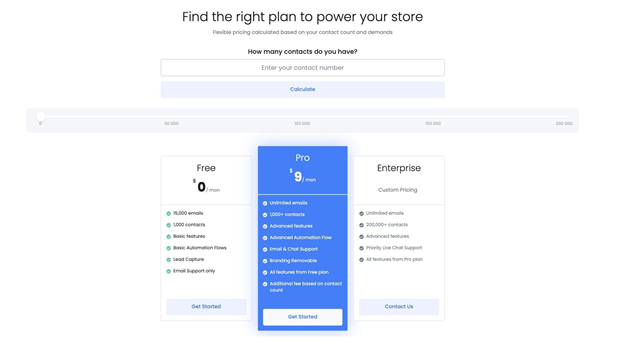
Active Campaign

Active Campaign’s feature is fairly intuitive for creating automation, and the drag-and-drop builder allows you to set up automated workflows in minutes.
You will also find pre-made templates to help you get started or get ideas. You also get reporting on everything, including click-maps, geo-tracking, and page visits. This will assist you in determining what is working and where people are paying attention.
Custom fields can be used to segment contacts (which are contact fields that include additional data about the contact, e.g., location or interests, etc.). Tags and custom fields can also be added or removed via automation. Another useful feature is Active Campaign’s lead scoring, which allows you to award scores based on subscribers’ past behavior.
This allows you to segment your audience from extremely engaged to completely inactive. As a result, you can make more informed choices about your marketing plan. Active Campaign provides a free plan, and paid plans start at $9/month.
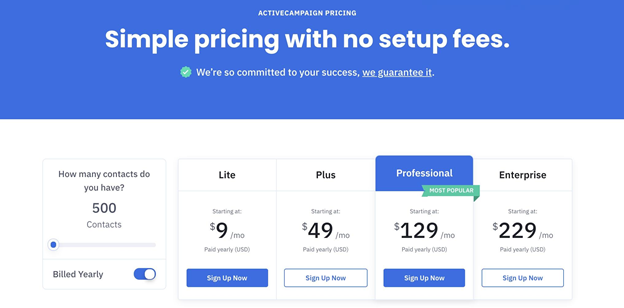
Campaign Monitor
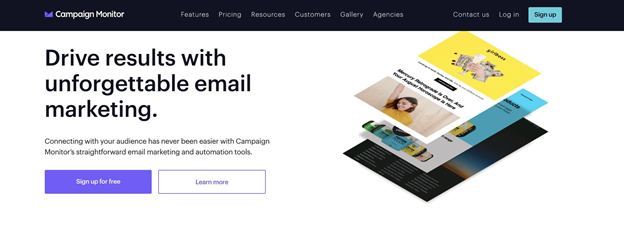
Every lead and email counts in real estate. As a result, Campaign Monitor enables you to easily integrate with a variety of CRM and event channels, ensuring that you have all the data you need to send customized email campaigns that drive revenue quickly.
It allows for real-time data monitoring. You get advanced email testing tools and analytics the moment you press send, allowing you to quickly monitor and maximize output in real-time.
Finally, you can see an overall picture of the success of your email marketing program, including engagement and acquisition, and campaign. Campaign Monitor offers a free plan for you to try out the app, and paid plans start at $9/month for 2,500 emails.

Ideas for real estate email marketing campaigns
Depending on your agency’s specialization, there are a lot of options for integrating email into your sales and marketing plan. Here are some real estate email examples you can try out.
Welcome email
A welcome email is an excellent way to greet new newsletter subscribers and introduce yourself to new clients. To put new clients at ease, use a warm and polite tone and show them your latest listings.
Listings newsletter

Send out listing newsletters on a consistent basis to showcase new properties to homebuyers and keep them up to date with the latest listings.
Open house invitation
Invite potential buyers to upcoming open-house events or seeking appointments with a friendly email invitation.
Email digest and tips
Share blog posts and real estate news in a monthly digest to establish your authority in the industry. Sending out a monthly tips newsletter is a perfect way to share your professional advice with first-time buyers and sellers who are new to the real estate market.
Follow-up email
Send a friendly follow-up email to nurture customer relationships even after a sale has gone through. This is a good opportunity to ask for feedback or a referral of your services.
Special offer
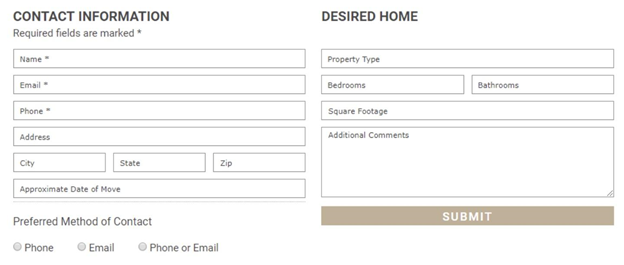
In addition to helping customers buy and sell homes, you can also offer special services such as:
-
Insights into real estate trends and news
-
Home valuations
-
Relocation assistance
-
Community-specific searches
Make use of these resources to generate new leads. Promote them on social media and your website, then develop a drip-email campaign that involves different emails for each service when new leads subscribe to your newsletter.
Each email should provide more information about each of your services. For example, if you provide relocation services, clarify your procedure and provide a contact form where interested subscribers can send their details.
Client testimonial

Your existing and previous clients are more convincing than any advertisement campaign you might launch. They have firsthand knowledge of the value you have, and leads are more inclined to trust their reviews than yours.
This isn’t always a negative thing. Simply put, you have the choice of using your current and previous customers’ interactions to persuade leads to become clients. As a result, rather than you discussing the advantages of working with you, your new and previous clients do it for you.
Use your drip email campaigns to ask your existing clients for testimonials. This approach has two benefits:
-
It helps you acquire data on your clients’ level of satisfaction.
-
It gives you a social proof to use on your website to sell properties.
Share the testimonials you get as part of your email promotions as well. This works well with leads who are nearing the end of their purchasing journey — they’ve been nurtured and are able to list their home or make a purchase. Seeing testimonials at this stage makes them feel confident that they made the right choice in hiring you as their agent.
Final words
That’s it! I hope this article has provided you with valuable information about real estate email marketing. Please feel free to leave comments below for a further discussion on this topic!
New Posts

How To Set Up Google Analytics 4 For Your BigCommerce Store






